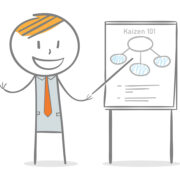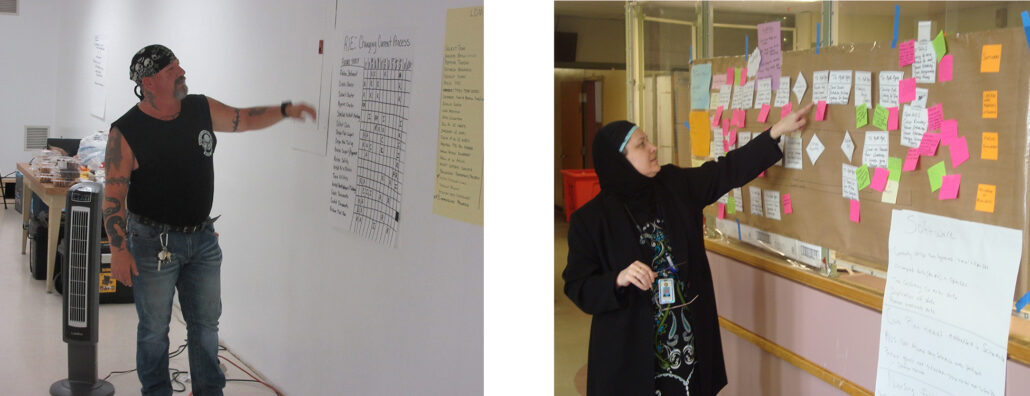Kaizen Events 101: Before, During and After. Your Checklist for a Holistic Three-Week Plan
By Amy Howard
 Kaizen Events are an effective implementation technique that is regularly employed as a means for accelerating results. The approach is a fundamental improvement mechanism that must be part of any successful change initiative. Also known as a Rapid Improvement Event or Accelerated Change Process, Kaizens are typically a one-week “small project” that focuses a dedicated team on an under-performing process or function.
Kaizen Events are an effective implementation technique that is regularly employed as a means for accelerating results. The approach is a fundamental improvement mechanism that must be part of any successful change initiative. Also known as a Rapid Improvement Event or Accelerated Change Process, Kaizens are typically a one-week “small project” that focuses a dedicated team on an under-performing process or function.
Why Do Kaizen Events?
Kaizen Events address one of John Kotter’s Eight Reasons Why Transformation Efforts Fail: Planning for and achieving near term wins. When embarking on the Lean journey, it is critical that the organization achieve some early wins to provide proof-of-concept and to build organizational energy and enthusiasm that “yes, things can change for the better!” One critical outcome is results that are immediate and measurable. Another critical activity and outcome is team-based problem solving — event teams develop a crisp understanding of where waste elimination opportunities exist and how to quantify and realize them by working together. Kaizen Events quickly get results, engage the organization in a structured way and create momentum, all of which are fundamental to an organization’s performance imperative.
When to Use Them (Hint… Don’t Overuse Them)
When all you have is a hammer, everything starts to look like a nail. Kaizen Events are a powerful implementation tool. However, they must be balanced and integrated into an approach that provides the structure and cadence necessary for sustainable process changes. This means:
- Allowing time for action items to be completed
- Developing and using relevant process measures, and
- Communicating to the broader organization …
all while getting the day-to-day work done.
Powering thru event after event is not a formula for long-term change, and can cause burn out. So, use them sparingly and on the right things, making sure prior efforts are “sticking” before taking on more.
Team Makeup
The structure of a Kaizen Event workshop customarily consists of a leadership / steering function, a sponsor from the steering team, a team leader who is part of the event team and the team itself — ideally made up of a cross-functional group of 5 to 9 individuals. The importance of assembling a cross-functional team is that it involves individuals who are directly involved in the process, it’s suppliers and customers (internal or external), and perhaps one or two people who are disconnected from the area but are known to ask insightful questions. This ensures you have the right content expertise related to the core process, plus provides relevant upstream and downstream views.

Kaizen Event Planning, Delivery and Follow-up
Once it’s been determined that a Kaizen Event is the appropriate vehicle to address a given problem, event planning and execution activities can begin. Holistically, the preparation, event conduct and follow-up activities typically span a three-week time period, a general outline of which is provided below.
Week One – Prep: Formally Plan, Define and Charter
- Scope – Define what’s in and out of play; understand if there are any constraints the team needs to operate within
- Surface expectations, set objectives and specify anticipated deliverables with Sponsor and key stakeholders
- Determine key performance and completion measures
- Identify team composition: Steering team members, event team members and any supplemental resources
- Validate timing and resources
- Manage for identified critical success factors
- Cooperatively plan facilitation and daily event calendar
- Communicate final planning to stakeholder community
Week Two – Delivery: Lead and Facilitate Event
- Event kick-off with opening comments from Sponsor. Empower the team to push the envelope
- Create awareness / conduct training on Lean tools that will be used during the event
- Map and (debate!) the current state. When in doubt, go see! Validate how things “really” work today, not how they are “supposed to work”
- Identify current performance – use available data and baseline everything
- Assess value-added vs. non value-added analysis of the process today. Identify, rate and validate improvement opportunities
- Create a plan that depicts the future state implementation – noting the benefit case, organizational mobilization path and applicable measures
- Immediately begin converting quick hits – Move it, Change it, Test it, Do it! Having much less waste, fewer errors and mistakes, less variation and more standard work
- Hold report-out with steering team, stakeholders and interested parties. Present event findings, opportunities, quick wins, next steps (30-day action plan), plus accountabilities, responsibilities and additional resources and leadership support needed to make it happen
- Celebrate!
Week Three – Follow-up: Execute the Plan
- Assist the team in executing to closure the action plan presented at the final report-out
- Document and communicate about process changes and progress – make relevant progress results visual to the organization
- Update applicable command media / process documentation to ensure the “new way” is the “only way”
- Round on the areas and team affected by / implementing the change. Coach, mentor and engage in the creation of counter-measures and provide support as the new process is adopted and fine-tuned
- Engage managers and teams via the Lean Daily Management System to track procedural adherence to the new process and monitor performance, always looking for ways to improve even more
***Kaufman Global is currently seeking hospital / VA clients based in the US who wish to conduct their first Kaizen Event. We are looking to exchange event facilitation at a deeply discounted rate for case study rights. If you would like to be considered, please contact Amy Howard via LinkedIn messaging.***

